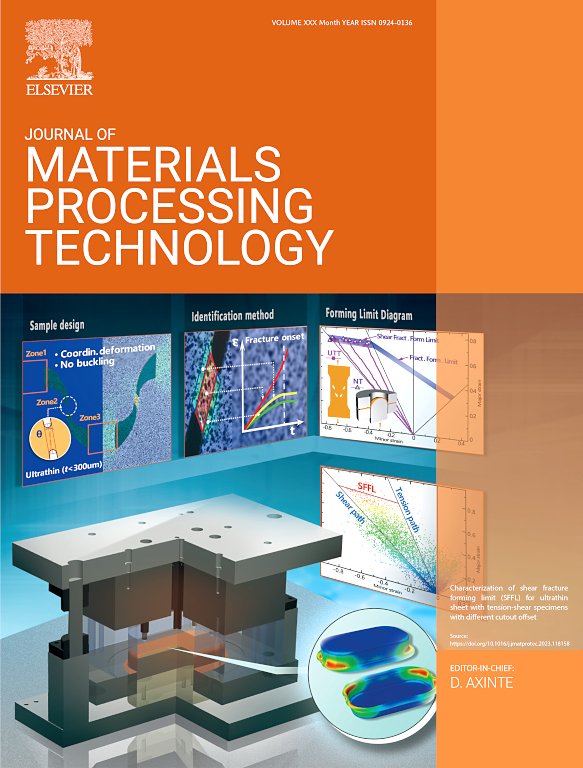Continuous and discontinuous dynamic recrystallization in the superplastic deformation of moderately cold-deformed Cr4Mo4Ni4V martensitic steel
IF 6.7
2区 材料科学
Q1 ENGINEERING, INDUSTRIAL
Journal of Materials Processing Technology
Pub Date : 2024-10-29
DOI:10.1016/j.jmatprotec.2024.118647
引用次数: 0
Abstract
This study employs lath martensite as the starting structure to achieve superplasticity through limited cold deformation, revealing how the dynamic recrystallization mechanism during superplastic deformation changes with the amount of prior cold deformation. Results show that an elongation close to 700 % can be achieved with 25 % cold deformation, and the peak stress is significantly reduced. The amount of deformation required to achieve superplasticity with martensite as the initial processing structure is much lower than with ferrite as the initial processing structure. However, when the deformation increased from 25 % to 50 %, the elongation increased only slightly, from 696 % to 756 %, while the peak stress increased from 90.1 MPa to 96.4 MPa. The reason is that continuous dynamic recrystallization (CDRX) is suppressed, and softening occurs only through discontinuous recrystallization (DDRX), thus weakening the softening effect. The superplastic deformation mechanism for samples with high cold deformation mainly involves grain boundary sliding (GBS) associated with DDRX, while for samples with moderate cold deformation, it involves GBS accompanied by both CDRX and DDRX. Strain rate jump (SRJ) tests reveal that even 5 % cold deformation can accelerate the growth of the m-value during deformation. Interestingly, the m-value of the 25 % deformed sample is slightly higher than that of the 50 % deformed sample. This research offers a promising route for achieving superplasticity in high-alloy low-carbon steel, revealing continuous and discontinuous dynamic recrystallization accompanied by grain boundary sliding in superplastic cold-deformed martensitic Cr4Mo4Ni4V steel.
中度冷变形 Cr4Mo4Ni4V 马氏体钢超塑性变形中的连续和不连续动态再结晶
本研究采用板条马氏体作为起始结构,通过有限的冷变形实现超塑性,揭示了超塑性变形过程中的动态再结晶机制如何随先前冷变形量的变化而变化。结果表明,25%的冷变形可实现接近700%的伸长率,峰值应力显著降低。以马氏体为初始加工结构时,实现超塑性所需的变形量远低于以铁素体为初始加工结构时的变形量。然而,当变形量从 25 % 增加到 50 % 时,伸长率仅略有增加,从 696 % 增加到 756 %,而峰值应力却从 90.1 兆帕增加到 96.4 兆帕。原因是连续动态再结晶(CDRX)受到抑制,软化仅通过不连续再结晶(DDRX)发生,从而削弱了软化效应。高冷变形样品的超塑性变形机制主要涉及与 DDRX 相关的晶界滑动(GBS),而中等冷变形样品的超塑性变形机制则涉及与 CDRX 和 DDRX 相关的 GBS。应变速率跃变(SRJ)测试表明,即使是 5% 的冷变形也会在变形过程中加速 m 值的增长。有趣的是,25% 变形样品的 m 值略高于 50% 变形样品的 m 值。这项研究揭示了超塑性冷变形马氏体 Cr4Mo4Ni4V 钢中伴随晶界滑动的连续和不连续动态再结晶,为实现高合金低碳钢的超塑性提供了一条可行的途径。
本文章由计算机程序翻译,如有差异,请以英文原文为准。
求助全文
约1分钟内获得全文
求助全文
来源期刊

Journal of Materials Processing Technology
工程技术-材料科学:综合
CiteScore
12.60
自引率
4.80%
发文量
403
审稿时长
29 days
期刊介绍:
The Journal of Materials Processing Technology covers the processing techniques used in manufacturing components from metals and other materials. The journal aims to publish full research papers of original, significant and rigorous work and so to contribute to increased production efficiency and improved component performance.
Areas of interest to the journal include:
• Casting, forming and machining
• Additive processing and joining technologies
• The evolution of material properties under the specific conditions met in manufacturing processes
• Surface engineering when it relates specifically to a manufacturing process
• Design and behavior of equipment and tools.
 求助内容:
求助内容: 应助结果提醒方式:
应助结果提醒方式:


